Crop failure is a term no farmer or humble gardener ever wants to hear. 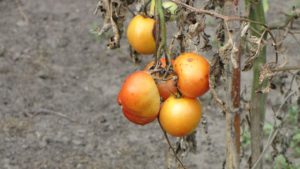 Nonetheless, it is something we all experience in the agricultural world. Whether you are a farmer, hobbyist, homesteader, or professional gardener like myself, crop failure can be brutal on your stomach, wallet, and ego. So what do you do if all your precious edibles go on to the great beyond?
Nonetheless, it is something we all experience in the agricultural world. Whether you are a farmer, hobbyist, homesteader, or professional gardener like myself, crop failure can be brutal on your stomach, wallet, and ego. So what do you do if all your precious edibles go on to the great beyond?
Here’s a few tips to help you recuperate.
Early Intervention
I have to say I am quite fortunate to have two parents who made agriculture their careers. My dad was a farmer, and my mom assisted farmers via Virginia State University (VSU) and the United States Department of Agriculture (USDA). Even after their workday was over, both of my parents enjoyed the spoils of fresh fruits and veggies from the garden. This introduced me to the concept of growing my own food, and pre-planning for potential crop failure.
 Crop failure can come as a result of numerous factors, including fickle weather, pests, and poor soil. Sure, there are options, such as hydroponic and aquaponic farming, however, not everyone has access or the ability to participate in such practices. Even then, you cannot completely escape the potential for failed crops. Thus, taking measures to plant a few extra crops, not use all of your seed, and plant in succession are necessary to help you recuperate quickly, should heavy rains or unexpected snow damage or kill you first plantings.
Crop failure can come as a result of numerous factors, including fickle weather, pests, and poor soil. Sure, there are options, such as hydroponic and aquaponic farming, however, not everyone has access or the ability to participate in such practices. Even then, you cannot completely escape the potential for failed crops. Thus, taking measures to plant a few extra crops, not use all of your seed, and plant in succession are necessary to help you recuperate quickly, should heavy rains or unexpected snow damage or kill you first plantings.
Best Laid Plans
Remember when I said I was fortunate to have parents in agriculture? Well, that didn’t exactly save me from the toils of crop failure this year.
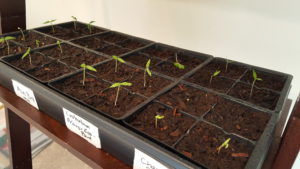 Though I have been working on FoodiO Farmers’ Market since 2015, this year is the first in which I have decided to offer my own produce. Due to inability to source locally grown produce consistently, I figured I could raise my own. It would not be the first time I raised a my own garden. However, it is the first time I have experienced mass crop failure.
Though I have been working on FoodiO Farmers’ Market since 2015, this year is the first in which I have decided to offer my own produce. Due to inability to source locally grown produce consistently, I figured I could raise my own. It would not be the first time I raised a my own garden. However, it is the first time I have experienced mass crop failure.
Over the years, I have worked in or raised gardens with my parents, friends, and alone, on my balcony. Each time, I took what I’d learned from watching my parents and planted extra just in case the weather foiled my plans of fresh homegrown produce. With the exception of some unfortunate pumpkins, I never experienced crop failure.
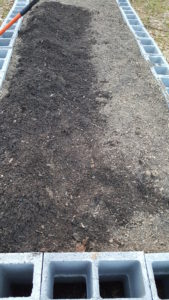 Sure, I had a few plants that didn’t produce as expected. Thankfully, though, said plants still produced something; often providing more than my family and I could consume on our own. I assumed utilizing the same methods, those noted above, would provide similar results.
Sure, I had a few plants that didn’t produce as expected. Thankfully, though, said plants still produced something; often providing more than my family and I could consume on our own. I assumed utilizing the same methods, those noted above, would provide similar results.
I was wrong.
Last week, when I went out to water my freshly planted tomato, tomatillo, and brussel sprout plants, I discovered almost all of them had disappeared.
Where could they have gone?
Dealing with Garden Pests
I saw no signs of bugs in my garden, so I knew the problem could not have come from them. Furthermore, the plants weren’t just damaged, they were completely gone. A few of the spots looked exactly like the holes I dug to plant my tomatoes. Thus, I concluded the culprit must have been voles (a small rodent related to mice, and a terror to your yard or garden). The other spots didn’t look disturbed at all, just bare.
Then moments later, I discovered my plants’ captor. My five month old, 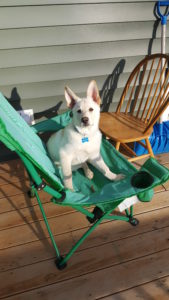 usually adorable, Husky-Sheppard named Bear.
usually adorable, Husky-Sheppard named Bear.
There he was, suddenly standing directly in my raised beds attempting to chomp down on my potato plants. Furious as I was, I realized there was no point getting angry at him. However, I did have a real problem on my hands.
In just a couple of weeks, my customers are expecting to have fresh fruits and veggies beyond the Collard Greens, Mesclun Salad Mix, and Spring (Green) Onions I have available year-round.
What could I do to fix this problem?
It was too late to start more plants from seed with the objective to sell at the market. I didn’t want to purchase plants from a nursery that utilized non-organic practices. It would be against FoodiO policy to offer non-local, non-heirloom produce. So, I did the only thing left to do.
I reached out to my friends with practices similar to mine.
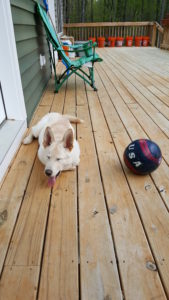 Thankfully, my gardener friends and I share seed. We share similar, if not identical practices; and most importantly we are interested in building a better, more sustainable community. Thanks to them, I will have fresh, locally grown, chemical-free produce for our deserving FoodiO Farmers’ Market customers.
Thankfully, my gardener friends and I share seed. We share similar, if not identical practices; and most importantly we are interested in building a better, more sustainable community. Thanks to them, I will have fresh, locally grown, chemical-free produce for our deserving FoodiO Farmers’ Market customers.
Bear on the other hand, will have a restraining order, barring him from the garden.